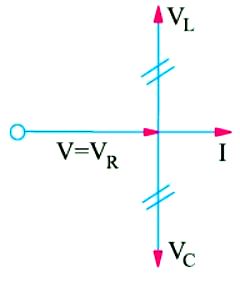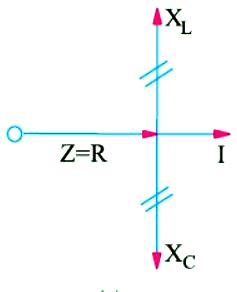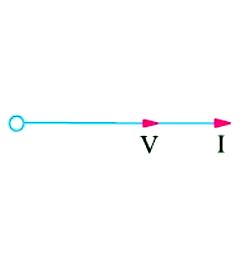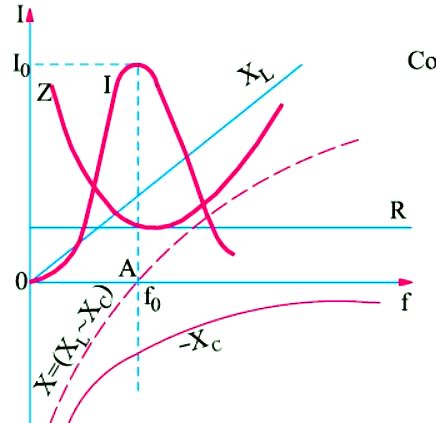Resonance in RLC Circuits
In this article we will discuss on Resonance in RLC Circuits, We have already seen from Article Resistance Inductance and Capacitance in Series that net reactance in RLC circuits of Figure (A) is
X = XL−XC and ![]()
Let such a circuit be connected across an A.C. source of constant voltage V but of frequency varying from zero to infinity. There would be a certain frequency of the applied voltage which would make XL equal to XC in magnitude. In that case, X = 0 an Z = R as shown in Figure (C). Under this condition, the circuit is said to be in electrical resonance.
As shown in Figure (C), VL = I.XL and VC = I.XC and the two are equal in magnitude but opposite in phase. Hence, they cancel each other out. The two reactance taken together act as a short-circuit since no voltage develops across them. Whole of the applied voltage drops across R so that V = VR. The circuit impedance Z = R. The phasor diagram for series resonance is shown in Figure (D).


Calculation of Resonant Frequency
The frequency at which the net reactance of the series circuit is zero is called the resonant frequency f0.
Its value can be found as under : XL − XC = 0 or XL = XC or ω0L = 1/ω0C
or
![]()
If L is in henry and C in farad, then f0 is given in Hz.
When a series R-L-C circuit is in resonance, it possesses minimum impedance Z = R.
Hence, circuit current is maximum, it being limited by value of R alone. The current I0 =V/R and is in phase with V.
AdBlock-2


Since circuit current is maximum, it produces large voltage drops across L and C. But these drops being equal and opposite, cancel each other out. Taken together, L an C from part of a circuit across which no voltage develops, however, large the current flowing. If it were not for the presence of R, such a resonant circuit would act like a short-circuit to currents of the frequency to which it resonates. Hence, a series resonant circuit is sometimes called acceptor circuit and the series resonance is often referred to as voltage resonance.
In fact, at resonance the series RLC circuit is reduced to a purely resistive circuit, as shown in Figure (A), (B), (C) & (D).
Incidentally, it may be noted that if XL and XC are shown at any frequency f, that the value of the resonant frequency of such a circuit can be found by the relation
![]()
Summary
When an R-L-C circuit is in resonance
1. Net reactance of the circuit is zero i.e. (XL − XC) = 0. or X = 0.
2. Circuit impedance is minimum i.e. Z = R. Consequently, circuit admittance is maximum.
3. Circuit current is maximum and is given by I0= V/Z0 = V/R.
4. Power dissipated is maximum i.e. P0 = I02R = V2/R
5. Circuit power factor angle θ = 0. Hence, power factor cos θ = 1.
6. Although VL = VC yet Vcoil is greater than VC because of its resistance.
7. At resonance, ω2LC = 1
8. Q = tan θ = tan 0° = 0

Graphical Representation of Resonance
Suppose an alternating voltage of constant magnitude, but of varying frequency is applied to an R-L-C circuit. The variations of resistance, inductive reactance XL and capacitive reactance XC with frequency are shown in Figure (E).
(i) Resistance : It is independent of f, hence, it is represented by a straight line.
(ii) Inductive Reactance : It is given by XL = ωL = 2π fL. As seen, XL is directly proportional to f i.e. XL increases linearly with f. Hence, its graph is a straight line passing through the origin.
(iii) Capacitive Reactance : It is given by XC = 1/ωC = 1/2π fC. Obviously, it is inversely proportional to f. Its graph is a rectangular hyperbola which is drawn in the fourth quadrant because XC is regarded negative. It is asymptotic to the horizontal axis at high frequencies and to the vertical axis at low frequencies.
(iv) Net Reactance : It is given by X = XL ~ XC. Its graph is a hyperbola (not rectangular) and crosses the X-axis at point A which represents resonant frequency f0.
(v) Circuit Impedance : It is given by ![]()
At low frequencies Z is large because XC is large. Since XC > XL, the net circuit reactance X is capacitive and the p.f. is leading [Figure (F)]. At high frequencies, Z is again large (because XL is large) but is inductive because XL > XC. Circuit impedance has minimum values at f0 given by Z = R because X = 0.
(vi) Current I0 : It is the reciprocal of the circuit impedance. When Z is low, I0 is high and vice versa. As seen, I0 has low value on both sides of f0 (because Z is large there) but has maximum value of I0 = V/R at resonance. Hence, maximum power is dissipated by the series circuit under resonant conditions. At frequencies below and above resonance, current decreases as shown in Figure (F).

Now, I0 = V/R and ![]()
Hence ![]() where X is the net circuit reactance at any frequency f.
where X is the net circuit reactance at any frequency f.
(vii) Power Factor : As pointed out earlier, X is capacitive below fo. Hence, current leads the applied voltage. However, at frequencies above fo, X is inductive. Hence, the current lags the applied voltage as shown in Figure (F). The power factor has maximum value of unity at fo.
Read article – constant voltage
Visit NCERTplanet.com for NCERT solutions and Textbook downloads




